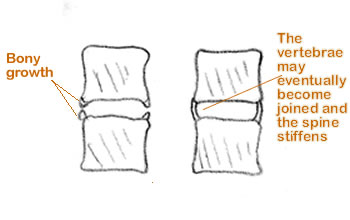Ankylosing Spondylitis- Symptoms and Treatment
Ankylosing Spondylitis (AS) is a type of spinal problem that causes the back to become stiff and inflexible. It is caused by initial inflammation of the spine where the ligaments or tendons attach to the bone (spond = bone, itis = inflammation).
As the inflammation settles extra bone is produced by the body and this can lead to bony bridges being formed between the vertebrae and stiffness follows this. This is the ankylosing part of the name.

Ankylosis of the spinal joints - showing the characteristic
bridging of the vertebrae with bony spurs
- AS affects about 1 in 200 men and 1 in 500 women in the UK.
- It can affect anyone but usually shows up in late teens or early twenties.
- Occasionally, the diagnosis of AS is missed in younger life and is only made when someone is older.
- It’s a bit hard to diagnose in the early stages as there may be no X-Ray changes, and it can be mistaken for simple lower back pain.
- The condition usually starts at the base of the spine in the sacroiliac joints.
- It can affect other joints, mainly the hips, shoulders and feet and ankles.

X-Ray showing the same bridging by the
bony spurs on the drawing above
Ankylosing Spondylitis Symptoms
If you think about the main disease process - inflammation followed by an ankylosis -the symptoms become easier to understand. If you have active joint inflammation this often makes your joints feel very stiff, especially when you wake up in the mornings. This is one of the first signs of this disease.
- Gradual onset of lower back pain and stiffness. The important thing here is the stiffness, usually worse in the morning and taking a good while to improve on rising. I have met sufferers of AS who are stiff for an hour or more on rising in the mornings.
- The stiffness usually wears off with exercise and movement as the day goes on.
- The lower back pain may radiate into the legs and buttocks.
- Weight loss, fatigue and fevers with night sweats often accompany the illness.
AS is a progressive disease that does need ongoing management but it can be controlled in most people and is not life threatening.
Treatment for Ankylosing Spondylitis
As the disease becomes more chronic it is vitally important to maintain as much movement as you can in your spine, as the spine gets stiffer you will need it to be in a good functional position.
The main ways that this is managed is using medication to control the disease and the pain and daily exercise to keep your spine moving as much as possible.
The main drugs prescribed are:
- Pain killers
- Non-Steroidal anti-inflammatory drugs
- Disease modifying drugs (DMARDS)
- Cortico steroids - either as a joint injection or tablet
- New drugs called Anti TNF medication can also be given.
Most of these need to be prescribed and managed by a rheumatologist.
The exercise programme needs to be tailored to your individual needs and carefully supervised. If you suspect you have AS discuss it with your doctor and if you have been diagnosed with this then you should have regular contact with your own physiotherapist and rheumatology specialist.
The National Ankylosing spondylitis Society has some very useful information.
if you have been diagnosed with AS this is a helpful score to help you rate the effectiveness of your treatment.
29-Jul-2017


